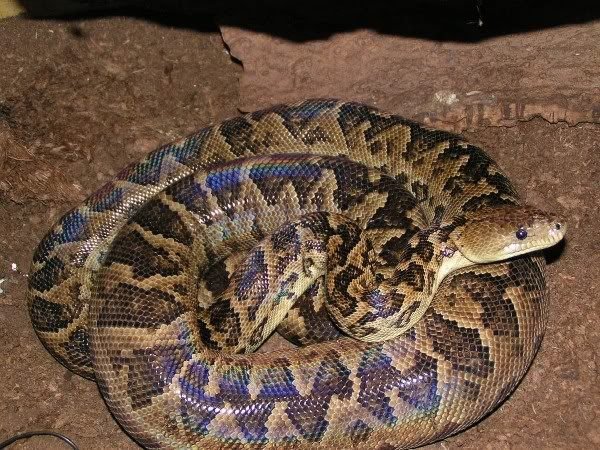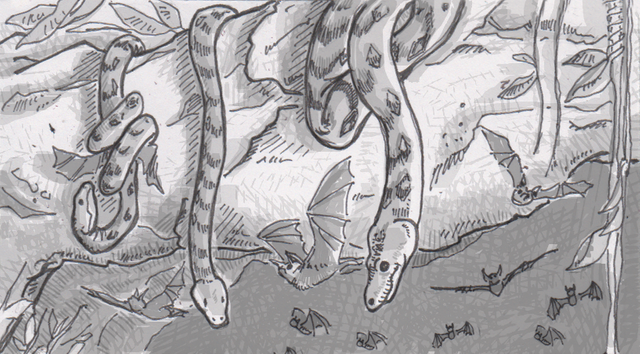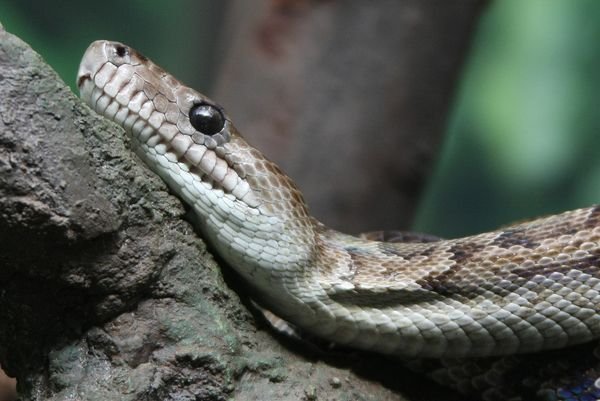Coordinated Hunting Among Snakes
In my last post, I pointed out several facts about the lives of snakes that debunk a popular urban legend. Among those facts, I stated that snakes really don't put much "planning" into capturing their prey, rather they simply catch and eat what they can when they can. However, a brand new study proves that this may not always be the case; studying Cuban boas, a research team from the University of Tennessee has revealed that some snakes conduct well-coordinated hunts in small groups to increase their chances of success!

Vladimir Dinets, a research assistant professor of psychology, led a team studying Cuban boas residing in the bat caves of the island. These boas feed almost exclusively on bats, hunting them as they leave the cave at dusk and return at dawn. Hunting bats can be an obvious challenge; to capture their prey, these snakes hang from the ceilings of the cave opening and attempt to grab bats in mid-flight as they speed past!
But hunting bats in this manner by no means guarantees success. Bats are relatively small, incredibly quick and fly in massive groups that make it hard to isolate a single individual to hunt. A lone snake hanging from the mouth of the cave has a very difficult time catching a bat as it is fairly easy to avoid. Using echolocation, the bats could sense the single predatory threat and fly around it, outside of it's striking distance; as a result, many of the hunts were unsuccessful. However, if more than one boa was present, they coordinated their positions to create a sort of wall across the mouth opening, making it almost impossible for a bat to pass through without being in striking distance of at least one boa. Because the bats can't avoid the snakes, these group hunts were successful every time, and the more boas were present, the less time it took each one to catch a bat.

Of all the 3,650 snake species in the world, only a small percentage have been observed hunting, so much is still unknown about the diversity of their hunting tactics. Until now, no coordination between individuals had been definitively proven, but researchers remain confident that it is likely it exists elsewhere.
"It is possible that coordinated hunting is not uncommon among snakes, but it will take a lot of very patient field research to find out." -Dinets Source
Cuban boas are facing extinction as they are hunted for food and the pet trade; today they can only be found in some of the most remote caves. This new study highlights a major problem for the boas: because they rely on these "packs" to hunt, if their numbers diminish too much, it may impact their ability to capture prey. Their teamwork will suffer as fewer and fewer snakes join in the hunt.
"I suspect that if their numbers in a cave fall, they can't hunt in groups anymore and might die out even if some of them don't get caught by hunters. A few of these caves are in national parks, but there's a lot of poaching everywhere." -Dinets Source

Video Link: 1
Article Link: https://www.sciencedaily.com/releases/2017/05/170523124136.htm
Very interesting. By the way first I thought you may have painted the picture of the hunting snakes. :-)
I was surprised that someone had actually take the time to draw snakes hunting from the cave ceiling! I posted the link to where I found the image but unfortunately I do not know who the artist is.
Yes, i've read about this.
I'm not a snakeman, but interesting.
I've never held a snake before. I'm not sure if I could do it. Snakes freak me out lol
I'd whole heartedly recommend trying it at least once with a professional snake handler! It can definitely be a scary experience at first but that fear often dissipates quickly once people see one up close in a safe setting. They are calm animals that often handle very well and are much less frightening up close. They aren't at all slimy or gross feeling, but dry and scaly. The trick that works best for me is that I tell people to feel their fingernails; scales are made of keratin, the same material as our hair and fingernails so the feeling is very similar!
Maybe one of these days! It would have to be with a harmless snake of course :) Sent you a follow.
Yes, that seems to be the case. I've seen a video about a certain kind of snakes, who gather at a paticular time and place. At this place monitor lizards lay their eggs in the sand. When the baby monitors hatch and come out of the ground, they try to sprint into the forest. The snakes systematically ambush them on their run. There is no doubt that the snakes know in advance that the monitors will hatch, and how they can catch them.
Yup! That video was one of the big features of the new Planet Earth series. It's still unclear whether that was cooperative hunting on the part of the snakes or just a bunch of individuals hunting the same prey in the same vicinity. But I believe they are looking into it more to figure out what was going on. Was it a snake free for all, or a coordinated effort? (I posted the video below for anyone who hasn't seen it!)
It didn't look like it was a coordinated hunt. They just all wait, and whoever can catch a monitor eats it.
But at least it shows, that the snakes have a certain knowledge about things that will happen in their local area. That means they have a concept of time, and knowledge about a particular place. Which raises the question how they learn this. They are not following their parents as youngsters and learn from them, like some animals do. So why do they go to this monitor nesting colony, at just the right time of the year? Very fascinating
True, from the video, it looks disorganized and very self serving; after all, the iguana can only be eaten by one snake. However observers did notice that the prey was often guided towards the rocks where there were more snakes, fewer areas to hide and a slimmer chance of escape. Maybe it's just a coincidence, but it is possible there is some strategy at play there.
You're right, reptiles are bizarrely good at anticipating events this like this. There is an island in the middle of the ocean when dozens of crocs gather to feed on sea turtles as they hatch. Interestingly, they all show up at once the day before the eggs hatch and leave immediately after. How they learned to come to the island and how they time their arrival so perfectly is still largely unknown.
At the very least it shows, that reptiles are "smarter" than we believed so far.
That seems to be kind of a trend with many animals, the more we learn about their behaviour. The biggest question for me is: how do they know these things?
I mean, with other animals its not so hard to explain, like elephants, wolves and lots of other mammals, who grow up with their parents and learn from them. But reptiles are usually not very social, and make their start into life on their own. There is still a lot to discover about that.
Back with the awesome articles. Right on!
thanks for this post :)
This is absolutely fascinating!